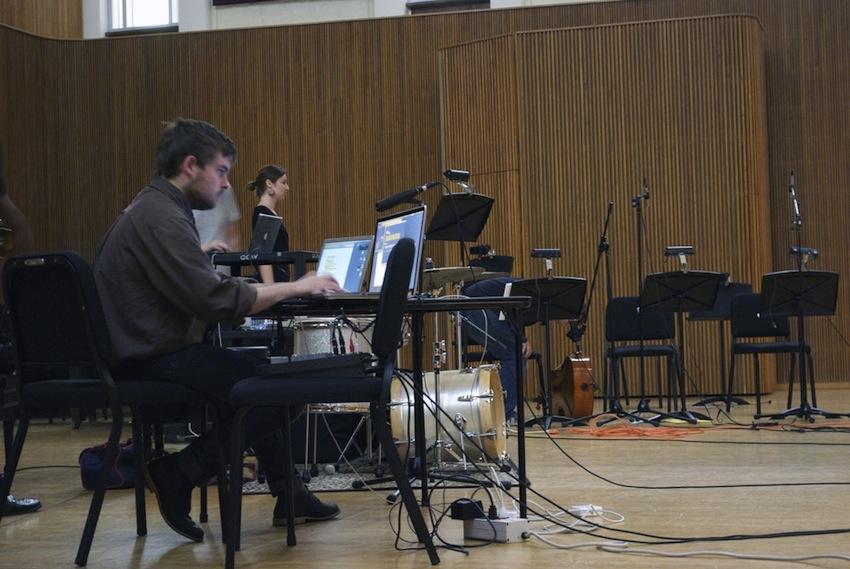Senior Recital Review: Orenstein Scores Scary Movie Classic
Double-degree senior Will Floyd assists with the realization of Matt Orenstein’s vision, an original score to the 1920 silent horror film The Cabinet of Dr. Caligari.
May 6, 2011
The Cabinet of Dr. Caligari is still a quirky horror movie from the 1920s, but as of Sunday, May 1, it is no longer silent. For his senior recital, double-degree fifth-year Matt Orenstein fulfilled his long-time “pipe dream” of composing a score for the entire 70-minute German Expressionist film.
Visually, the film resembles an eerie cross between the worlds of Dr. Seuss and Tim Burton. Everything is cockeyed and nothing stands at a right angle — even doors and windows hang like off-kilter parallelograms. The plot follows a creepy old man who sets up a display booth at a carnival for his spectacle: the somnambulist, the sleepwalker Cesare, who only wakes up from his “death-like slumber” when called upon by his master (the man we initially believe to be Dr. Caligari). When several mysterious murders take place in town, it becomes clear that the supposed Dr. Caligari has manipulated Cesare to kill while sleepwalking.
Sitting in Warner Concert Hall watching the muted colors and construction-paper-like designs flicker on a small projection screen was a surreal cross between kicking back to watch a movie in theaters and attending a formal recital. On stage behind the screen was an ensemble, comprised of electric and upright/acoustic basses (Orenstein), an alto saxophone (double-degree junior Tim Bennett), live electronics (double-degree senior Will Floyd), a cello (Conservatory senior Xochi John), violin (Conservatory senior Sara Sasaki), a viola (double-degree senior and Review staffer Hannah Selin) and percussion (Conservatory senior Austin Vaughn).
With a setup like this, it would be easy for a disconnect to form between the film itself and the music playing (literally) behind it — hearing live music while watching a recorded film isn’t something you experience every day. But that didn’t matter: The score so effectively complemented the film that I often found myself forgetting about the players behind the screen.
Orenstein employed the array of instruments on stage in unexpected and delightful ways. When the main character, Francis, first goes to the old man’s house to investigate the somnambulist, the alto saxophone and percussion played a witty, syncopated melody, which mirrored the old man’s mischievous giggles. The recurring theme that played during the carnival was especially exciting. It also later reappeared in a creepier, distorted form when we discover that Dr. Caligari is in fact a dead psychologist whose corrupt studies on somnambulism the old man has mimicked obsessively.
When appearing most conspicuously, the score’s electronic element pushes the music to a fever pitch: Controlled static sounds whirl and buzz, consuming all other instruments like a rolling storm cloud that swallows the cotton-ball-puffs in its path. Winding through the electronic sounds, the strings players let bows slide abrasively against strings to produce breathy siren-sounds — eventually transitioning into a response to the buzzing electronic sound.
In the film’s last act, the score’s only words appear in the form of a distorted choir and symphony recording, singing indecipherably through the recurring electronic cloud and strings that squealed from a distance. During this, both the creepy old man — who turns out to be the director of an insane asylum and not the famously murderous Dr. Caligari — and the main character, Francis, spiral deeper into psychosis before our eyes. Both the score and the film abandon comedy to render the absurd and disturbing world of madness.
Orenstein’s score didn’t always line up with soundtrack norms. On one occasion, Francis yells wildly and swings his arms to interrogate Dr. Caligari, but the music remains fairly calm and meandered subtly between playful and menacing. In another case, when Cesare (the murderous sleep-walker) kidnaps the beautiful Jane, the score won’t let us feel pure fear or disgust. Instead, the violent act is imbued with a strange tenderness. Yet these contrasts made the two compositions all the more integral to one another.
Orenstein deftly handled the challenge of synchronizing a live performance with a work of fixed visual media, and the score he composed fit the visuals like a second skin. It was easy to forget that the film was written for silence, and existed for years before someone gave it a 21st-century update.
















